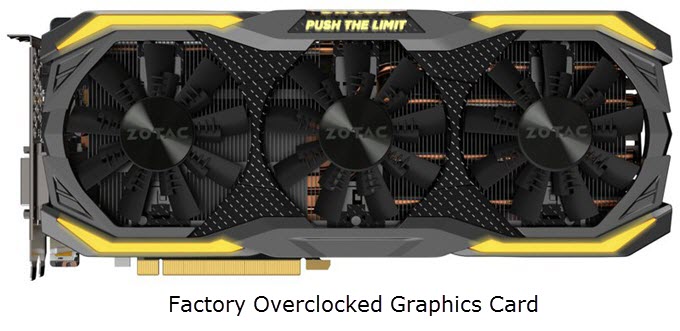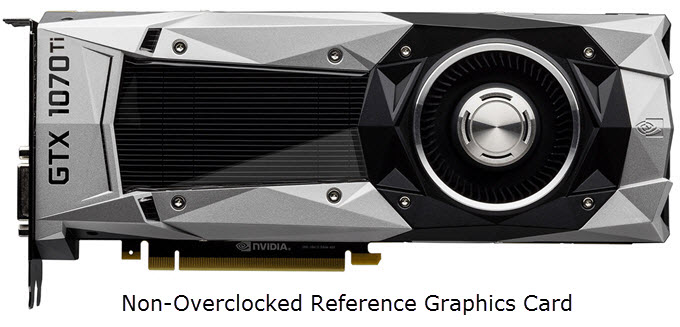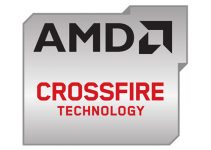There are generally two types of graphics cards that you can find in the market whether from Nvidia or AMD. The first ones are the reference graphics cards or non-overclocked graphics cards that come with stock frequencies specified by the GPU manufacturer. Another is the overclocked graphics cards or overclocked (OC) edition graphics cards that come with higher GPU and VRAM frequencies and offers better performance than its non-overclocked brothers. However, overclocked graphics cards cost a bit more than non-overclocked graphics cards. Also, you may be able to overclock a non-overclocked graphics card but not by much. So, are these factory overclocked graphics cards worth the extra price or not? To answer this question, I am going to make a complete comparison between overclocked and non-overclocked / reference graphics cards, so that you can make an informed decision when buying a graphics card for gaming.
Must Read:
Factory Overclocked Graphics Cards
Factory overclocked graphics cards come with higher GPU & VRAM frequencies or they can be easily overclocked to higher GPU and Video Memory clock speeds. These overclocked graphics cards come with better cooling and some of them have more power phases to give the card extra stability during overclocking. Some overclocked graphics cards also come with a liquid cooler that offers higher overclocking potential and lower temperatures. Below you can see a factory overclocked graphics card from Zotac.

These factory overclocked graphics cards offer around a 10% to 20% performance increase over their non-overclocked counterparts. Also, they are a bit more expensive than their non-overclocked variants. These factory overclocked graphics cards can cost around 30 to 40 dollars (or maybe more) higher than the non-overclocked graphics cards. Almost all the graphics cards manufacturers offer OC edition graphics cards and the degree of overclocking depends on the card model, cooler used, and the number of VRMs or power phases used on the graphics card. Graphics cards using more fans (dual or triple fans), better heatsinks with copper heatpipes and a higher number of VRMs have better overclocking capabilities and are generally overclocked higher. Also, factory overclocked graphics cards consume a bit more power and may include more 6-pin / 8-pin PCI-Express power connectors as compared to the reference or Non-OC graphics cards.
Must Read: Graphics Card Components Explained in Detail
Generally, there are two types of Factory Overclocked Graphics Cards:
Factory Pre-Overclocked Graphics Cards
These graphics cards come directly pre-overclocked from the factory or the manufacturer and you do not have to do anything through software or utility. You just have to plug these overclocked in the PCI-Express x16 slot, install the video drivers and just sit back and relax. When you run any GPU info software then you will be able to see higher GPU and VRAM frequencies in it.
Factory Tested Overclocked Graphics Cards
These overclocked graphics cards are tested for higher frequencies by the manufacturer but they come with the stock frequencies from the factory. So, when you plug these graphics cards in your PC and use GPU-Z or any other graphics card info tool to detect the GPU and Video Memory clock speeds then you will get the default stock frequencies shown there. These graphics cards come with their own overclocking software and using them you can easily overclock them to the higher tested frequencies with a single click (One-click Overclocking). After that, your graphics card will run at those higher overclocked frequencies and thus giving you extra performance in games and other applications. You can also reset the graphics card to their original stock frequencies any time you want. The only difference between these graphics cards and the pre-overclocked graphics cards is that in these graphics cards you have to perform some extra steps and use its GPU OC software to run them at their higher advertised speeds.


Can you overclock a factory overclocked card?
Yes, you can overclock a factory overclocked or already overclocked graphics card but this may not apply to all factory overclocked graphics cards. This is because some overclocked graphics cards have some room left for overclocking and some don’t. Also, if the graphics card is fitted with a good cooler, has more power phases, and allows voltage modifications then you may be able to overclock higher to extract every bit of performance from it.
Self Manual Overclocking of Non-Overclocked Graphics Cards
It is a fact that if you want to increase the performance of your graphics card then you have to overclock it. You can overclock your graphics card using graphics card overclocking software that can be downloaded from the internet for free. But there are some issues or dangers of manual or self overclocking. If done incorrectly then overclocking results in overheating of your GPU, VRAM & VRM and can lead to damage to your video card. Also, it can also result in the instability of your graphics card and this may cause freezing, BSOD, and frequent restarting in the operating system.

A non-overclocked graphics card generally comes with an average heatsink and fan. Normally you would see a single fan and heatsink without heatpipes on a non-overclocked graphics card. Also, their voltages are locked in the GPU BIOS and you cannot fiddle with it to achieve stable and high overclocks. Reference graphics cards from Nvidia and AMD come with a blower-type fan with average aluminum heatsink assembly and they generally run hotter and cannot be overclocked to higher levels. If your non-overclocked graphics card comes with a better cooling then you may be able to overclock it to the levels of the OC Edition variant of it. Generally, you will find small form factor (SFF) and low profile graphics cards come with stock frequencies. You can check out the guide on graphics card overclocking from the link given below.
Check out: Short Guide on Overclocking Graphics Cards
Factory Overclocked vs Reference / Non-Overclocked Graphics Cards
| Reference/ Non-Overclocked Graphics Cards | Factory Overclocked Graphics Cards | |
| GPU / VRAM Clock Frequencies | Default or Stock Clock Speeds specified by the GPU manufacturer | Higher than the Stock Speeds |
| Cooling | Average, generally comes with only one fan | Better, comes with two or triple fans, and some high-end GPUs come with liquid/water cooler |
| Stability | Stable at Stock Speeds / May remain stable at minor overclocked speeds | Stable at even Overclocked Speeds |
| Power Consumption | Normal as specified by the GPU manufacturer | Can be higher than the Reference / Stock cards. Some may require extra 6-pin/8-pin power connectors |
| Features | Normal Features | Can be higher than the reference / non-OC cards e.g. LED lighting, metal backplate, etc. |
| Price | Normal | Higher than the reference/stock cards |
See also: Blower Type Fan vs Open Air Fan GPU Coolers
So, which one to buy?
Overclocked graphics cards do offer some significant amount of performance improvements over reference graphics cards or non-graphics cards having stock frequencies. But are they worth the extra price? Well, it depends on the user requirements, preference, and budget, because if you can spend a few bucks more and want the best performing card in its segment then factory overclocked graphics cards really make sense. I personally do prefer the OC Edition graphics cards rather than buying the plain vanilla variant with stock frequencies.
On the other hand, if you are on a tight budget and are experienced enough to overclock a non-overclocked graphics card then you should get a non-overclocked variant of that graphics card. You may not be able to overclock it higher but you some overclock is possible. If you still have some doubts about graphics card overclocking or choosing a graphics card for yourself, then you can ask me your queries by leaving a comment below.
(*This post may contain affiliate links, which means I may receive a small commission if you choose to purchase through the links I provide (at no extra cost to you). Thank you for supporting the work I put into this site!)

![Graphics Cards Slot Width Explained [Single, Dual, 2.2, 2.3, 2.5, 2.75] Graphics Cards Slot Width Explained [Single, Dual, 2.2, 2.3, 2.5, 2.75]](https://graphicscardhub.com/wp-content/uploads/2019/09/graphics-card-slot-width-size-211x150.jpg)

hello i am buying a new pc next week and i need to chosse bettwen the rtx 2070 OC edition PNY xlr8 2 fans or a rtx 2070 msi armor normal not OC edition. wich 1 souled i take?
thank u very much for the help,
I would say get whichever is cheaper because you can always overclock the Non-OC cards to the overclocked ones if you want to you. And RTX 2070 is already such a powerful card that if you don’t overclock it then also it will not make any major difference at all. So, grab the one with the best deal.
ok thank very much,and do u know wich 1 have better cooling?
Both of them come with dual fan, but the MSI’s heatsink comes with copper heatpipes for better heat transfer and cooling performance. So, clearly MSI has got better cooling.
cpu:2600x
motherborad:B450M-DS3H – Gigabyte
ram:g-skill 16gb 3000mhz cl15
gpu:msi rtx 2070
pny 240gb and 1tb 7200rpm
psu: 550w plus 80
couger led case
is this a good pc for gameing or i can get some thing better?
I think it is a pretty good build for 1080p / 1440p gaming.
hello i boght this rig in the end:
psu 650w gold
msi rtx 2070 armor
amd 2600x
msi 470x gameing plus
g skiil cl 15 16gb ram
i have a problem with the pc. i games like the forst and pubg the cpu temps go up to 85-93c with the stock cooler and 2 front case fans runing at 3.9hz. any tipes to improve cooling and is that going to ruin my cpu?
Hello, those are pretty high temperatures as the maximum operating temperature for Ryzen 5 2600X is 95°C. Above this temperature the CPU will throttle down to lower clock speeds to save itself from any damage, and it will drastically impact performance. Here are some things you can try:
1. Check if the installation is secure and tight.
2. Apply a good quality thermal paste, I suggest using Arctic MX-4
Also, the wraith spire stock cooler is not good for Ryzen 5 2600X, and i highly recommend you to get a good aftermarket CPU cooler. I strongly suggest Scythe Mugen 5 Rev.B CPU Cooler (https://graphicscardhub.com/budget-cpu-cooler/). By the way, which software are you using for monitoring temps?
Nice job !
ryzen master and msi commend app both show 80c-93c in game idle 46-63c ok i wll try this tips thank you,you think its might be becuase hot air dont flow out of the case because i dont fell while in game hot air comeing out myabe its because i have only 2fans in the fornt and none in the back?
Exhaust fan is very important for taking the hot air out and you must install it asap. Also, what is your ambient or room temperature?
hello, since its winter here its cold and i think the temperature in the room is around 20
Hello, I want to build a tower and now considering to get RTX 2080 Ti. I’m not sure should get the stock or the oc version.
Get the one that is cheaper, but avoid the single fan version with blower type fan. Here are some good options to choose from https://graphicscardhub.com/best-rtx-2080-ti/
I just bought all my parts for my streaming gaming and editing pc
CPU: AMD Ryzen 7 2700X 3.7 GHz 8-Core Processor ($194.89 @ OutletPC)
CPU Cooler: Cooler Master Hyper 212 Black Edition 42 CFM CPU Cooler ($36.89 @ OutletPC)
Motherboard: Asus ROG STRIX B450-F GAMING ATX AM4 Motherboard ($119.89 @ OutletPC)
Memory: OLOy WarHawk RGB 32 GB (2 x 16 GB) DDR4-3200 Memory ($135.99 @ Newegg)
Storage: Western Digital Black NVMe 500 GB M.2-2280 NVME Solid State Drive ($92.89 @ OutletPC)
Storage: Western Digital Caviar Blue 1 TB 3.5″ 7200RPM Internal Hard Drive ($40.75 @ Amazon)
Video Card: Asus GeForce GTX 1660 Ti 6 GB STRIX GAMING OC Video Card ($329.89 @ OutletPC)
Case: Cooler Master MasterBox NR600 (w/o ODD) ATX Mid Tower Case ($69.98 @ Amazon)
Power Supply: Corsair CXM 650 W 80+ Bronze Certified Semi-modular ATX Power Supply ($69.88 @ OutletPC)
Case Fan: Cooler Master MF120R ARGB 3in1 59 CFM 120 mm Fans ($55.75 @ B&H)
Case Fan: Cooler Master MF120R ARGB 3in1 59 CFM 120 mm Fans ($55.75 @ B&H)
Great configuration for the price. It will serve you good for both gaming and video editing.
What if I bought a OC variant and it has a 6/8pin power connector, is it required to plug some pins in or you can just use it without plugging more power pins into the Graphics Card?
Thanks in advance!
If the card has 6-pin or 8-pin pin PCIe connector then you have to plug in the required connector from the PSU.
Can I overclock a GTX 650 ti 2gb zotac edition video card to achieve speeds on similar to the base GTX 650 ti boost?
May be you can if the card has a good cooler.
I have a watercooled custom loop machine built with a 2080 ti evga non oc. Can i oc this? Idk how much fps id get as the 2080 ti pretty much runs everything at high fps. I have an i9 9900k in it. Since its water cooled id imagine id never have to worry bout temps
Overclocking an RTX 2080 Ti makes no sense unless you are trying to break some benchmarking score. The performance boost you will get in games is very marginal.
How do I know if my GPU is factory OC or not? Also if its factory OC, how do I know whether or not it can be further OC manually or not?
Compare your GPU clock speed with the reference GPU clocks listed on https://www.nvidia.com/en-us/geforce/. If your GPU clock is higher then your card is factory overclocked otherwise not. To find your GPU clock speed, use GPU-Z tool https://www.techpowerup.com/gpuz/